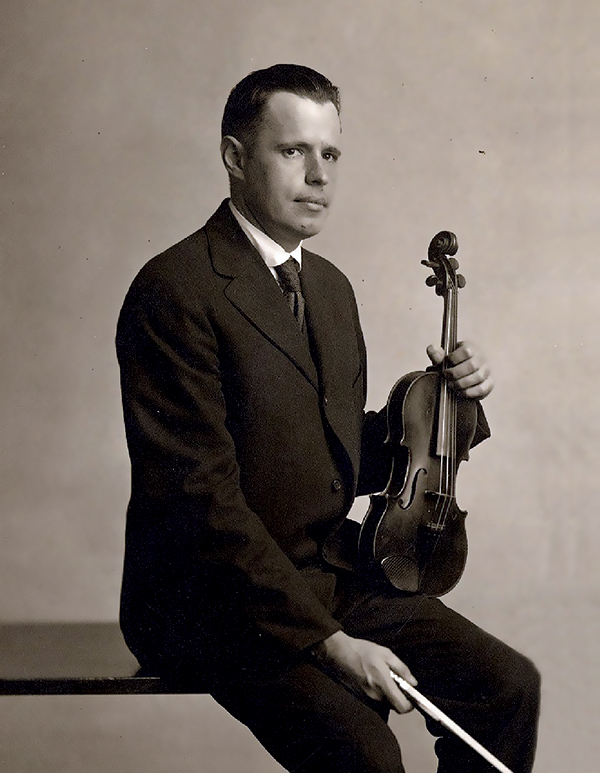INSIDE THE ORCHESTRA: The Concertmaster
by Tyler M. Secor
Inside the Orchestra seeks to demystify the many routines or rituals that are often part of any orchestra concert. From the modern perspective, these routines seem fixed, but historical context demonstrates that the typical “orchestra concert” has rapidly and significantly changed.
The lights dim, the crowd hushes and the routine of each concert begins with a violin player standing. But why? Who is that violinist? What are they doing?
That violinist is called the concertmaster. Generally speaking, the concertmaster is the leader of the orchestra, but the role of the concertmaster has changed from century to century and, in the 1800s, from city to city.
Until the early 19th century, instrumental music was typically led by one or more of the performers within the ensemble. According to John Spitzer and Neal Zaslaw in their book, The Birth of the Orchestra, there were three types of leaders in the 18th century: “the timebeater, the keyboard director, and the violin leader.” Simply put, the keyboard director led from the keyboard, the violin leader from the violin, and the timebeater beat time visually and/or audibly. Yes, audibly, and it was done by striking the “baton against a music stand or the stage apron, making a ‘noise as if he were splitting wood.’”
In the 18th century, the preferred method of leading an ensemble was by example from the keyboard and/or from the violin. Similar to the timebeaters, keyboard leaders were often encouraged to shout beats over the ensemble. Francesco Maria Veracini (1690–1768), Italian composer and violinist, suggested that the keyboard player should begin a piece by shouting “ONE” and then “to begin marking the beat visibly with this body and audibly by stamping his feet until the entire orchestra has joined in at the desired tempo.” Wouldn’t that make for a different concert experience?
But “by the end of the 18th century every major European orchestra was led by the first violinist,” remarks Spitzer and Zaslaw. The responsibilities of these early concertmasters were vast: setting tempos, leading rehearsals, selecting musicians to play in the orchestra, making the seating assignments, giving cues to singers, filling in missed entrances and even saving the performance from disaster. Francesco Galeazzi (1758–1819), Italian concertmaster of the Teatro Valle in Rome, wrote that concertmasters should shout cues to the orchestra and “when he senses the need, he should stamp his foot.” Those 18th-century concertmasters were so immersed in responsibility that Galeazzi remarked, “if an opera goes well, it is the first violin [i.e. concertmaster] who will receive the praise, and if it goes poorly, it is he who will be blamed.”
 CSO Concertmaster Emil Heermann, among the longest-tenured concertmasters in the Orchestra’s history (1910–46).
CSO Concertmaster Emil Heermann, among the longest-tenured concertmasters in the Orchestra’s history (1910–46).
With that level of responsibility, finding the right concertmaster was of utmost importance. Johann Joachim Quantz (1697–1773) was a German flutist, flute maker and composer who wrote about the qualities necessary to be a concertmaster. For example, the concertmaster should be friendly and affable, and they should command respect “in order to achieve reasonable and proper orchestral discipline in such matters as style and uniformity of bowing, fingering, timbre, ornamentation, intonation and expression.”*
With the rise of the conductor in the 19th century and the administrative business that formed around orchestras in the early 20th century, the concertmaster’s scope of leadership began to diminish. Today, concertmasters serve as liaisons and/or translators between the conductor and the orchestra. But concertmasters still ensure uniformity of bowing, fingering, ornamentation, intonation and expression across the entire ensemble. And, in the case of the CSO’s concertmasters, are still friendly and affable.
So, when the concertmaster stands at the beginning of the concert to signal the principal oboe to give the tuning note, this is just one of many responsibilities to ensure each performance presents the orchestra at its best.
CSO CONCERTMASTERS
- Henry Schmitt, 1895
- Josef Marian, 1895–1904
- Hugo Olk, 1905–07
- Hugo Heermann 1909–10
- Emil Heermann, 1910–46
- Sigmund Effron, 1946–73
- Phil Ruder 1973–95
- Alexander Kerr, 1996–97 (also Acting Concertmaster, 1995-96)
- Timothy Lees, 1998–2018
- Stefani Matsuo, 2019–present
*From Robin Stowell’s article “‘Good Execution and Other Necessary Skills’: The Role of the Concertmaster in the Late 18th Century” from Early Music, 1988.